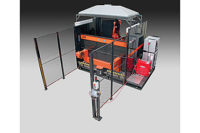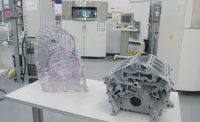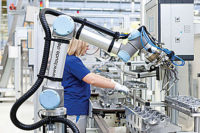Most model railroad enthusiasts love to build custom layouts piece by piece. However, some hobbyists prefer to purchase a preformed layout that includes track and scenery—all they have to do is plug it in and start running their trains.
When it comes to robots, manufacturing engineers have similar options. And, more are choosing to purchase pre-engineered, standard workcells that offer ready-to-go automation.
Preconfigured robotic cells contain common components to shorten delivery time, increase installation speed and reduce the cost of automation. They appeal to both small and large manufacturers in a wide variety of industries.
Several systems integrators have modular cells that are designed for adhesive dispensing, machine loading, palletizing, parts picking, screwdriving, test and inspection, welding and other assembly applications.
Pre-engineered cells are not new. In fact, they’ve been widely used for welding applications for more than a decade. For instance, Lincoln Electric has an automation division that integrates robotic arc welding equipment to help manufacturers decrease costs, increase weld quality and improve welding productivity.
“Preconfigured or pre-engineered means limited customization,” says Peter Griffith, general manager at Lincoln Electric Automation. “You don’t start with a blank page, but instead create a menu of cells that all have a place and purpose. We define and set the available work zone dimensions, arms and options.
“The goal is to create something configurable—more like Lego blocks—to drive down the custom-engineered content,” explains Griffith. “When we commit fewer resources to a project and can utilize common components, it drives price and delivery down for the customer. That creates an all-around better product that is exponentially easier to support.
“For welding specifically, a pre-engineered cell is an off-the-shelf item that comes ‘spark ready,’ which essentially means ready for welding out of the box,” Griffith points out.
Lincoln Electric offers two lines of standard robotic cells dubbed Fab-Pak and Pro-Pak. Each comes equipped with a six-axis FANUC robot. One of its newest offerings is the Fab-Pak Cobot, which features a FANUC CR-7iA collaborative arc welding arm. The robot is bolted to a 20-by-30-inch table equipped with casters for maneuvering around different parts of a factory.
Prepackaged Production
Acieta is another systems integrator that prepackages FANUC robots for welding applications. Each cell is ready to work with Lincoln or Miller power sources and wire feeders. Software and safety barriers are built into each heavy-duty 8-by-8-foot table. In addition, all utilities are integrated into the frame for faster start-up time.
Acieta launched its FastARC robotic weld cell three years ago. Four versions are currently available to meet a variety of needs. Most feature a FANUC Arc Mate 100iD/12 six-axis robot and a R-30iB PLUS controller.
“All utilities are integrated into the base,” says Nick Cowell, automation engineer at Acieta. “You can easily pick it up with a forklift and move it to a different location in your facility or to another plant in a different location. Then, all you have to do is hook up power or other utilities and you’re ready to go.
“Today, a lot of manufacturers are having trouble hiring and retaining welders,” notes Cowell. “Standard robotic weld cells help address that issue and enable operators to work on more value-added tasks.”
Acieta recently unveiled the FastLOAD DR2000, which is aimed at machine loading applications.
“Companies using the [machine] typically see a return on investment in 24 months or less, because they increase capacity and can reduce the cost per part,” claims Mark Sumner, vice president of sales and marketing at Acieta. “It’s a low-risk option to invest in automation and address business challenges fast.
“FastLOAD can tend up to three machines simultaneously, so an operator can [tackle other tasks] while the robot is working,” says Sumner. “This allows companies to leverage existing machines that may otherwise not be in operation due to labor shortages.”
“One of the big advantages of using preconfigured machines such as FastLOAD is much faster lead times,” adds Jake Corning, product manager and mechanical engineer at Acieta. “You can get systems in a few weeks instead of a few months. Another advantage is ease of set up. Because a lot of standard programming is already built in, you don’t have to program the entire cell from scratch.
“It’s a great product for small job shops that do a lot of low-volume, high-mix work, because they can just hook up the robot and go,” explains Corning. “However, preconfigured cells also appeal to larger manufacturers.”
Another new preconfigured robot offering is the jobHopper from Applied Manufacturing Technologies. The portable automation station for pick-and-place, machine tending and inspection applications features a FANUC six-axis cobot, controller, software, gripper and quick-change tooling.
The cobot sits on a steel-frame cart with locking casters for mobility. Since it does not require fencing or sophisticated programming, the jobHopper can be quickly deployed throughout an assembly plant.
“Engineers are very receptive to the concept of standardized robotic cells,” claims Dave Fox, president of CIM Systems Inc. “No matter the size of manufacturer or industry, everyone is having trouble finding people today. Pre-engineered robots can help address that issue and fill some of the voids on plant floors.”
CIM Systems offers pre-configured robotic cells for applications such as deburring, parts feeding and testing. Its latest product is a flexible palletizer that’s available with either a six-axis ABB or FANUC robot.
“Robotic cells use a standardized design and standard components, so installation is much faster,” says Fox. “It only takes about one day vs. a week or more with standard robots. Costs can be about 25 percent lower, because there’s less engineering and less risk involved.
“If we’ve already designed something for company A and we can use 90 percent of it for company B, things just go much quicker,” Fox points out. “For instance, we can often use the same blueprints for the electrical and mechanical design elements.”
“The mechanical design portion of any automation project is typically 15 percent to 25 percent of the cost of the project,” adds Matt Jurczyszyn, vice president of solutions at Kuka Robotics Corp. “Whenever you design a piece of custom equipment, it takes a lot of time to get it through the engineering process.”
Modular Cells
KUKA recently launched its cell4 production package in the United States. The modular, scalable cells are available in multiple configurations for applications such as arc welding, friction stir welding, machine tending, screwdriving, spot welding and ultrasonic welding.
“We have designed standard cells that can be flexible enough to meet about 75 percent of all manufacturing applications,” claims Jurczyszyn. “They’re all designed on the same mechanical platform.
“The machine base is identical throughout all the different varieties of cells,” says Jurczyszyn. “The controls architecture is also the same. This common design allows us to control costs by reducing build time and installation time.”
Another company that’s bullish on pre-configured robots is Chicago Electric. It unveiled the PickBot at the ASSEMBLY Show two years ago. The machine features a 3D-vision system from Solomon that enables random bin-picking applications.
Object recognition and location is established in 1 second, providing fast cycle times. Three versions of the PickBot are currently available with different robot options, including the ABB IRB 1200, the Motoman GP8 and the UR10.
“We just finished developing a new machine called the PalletBot, and we’re currently developing the GoBot, which is a mobile system that will be launched early next year,” says Bob Kaska, vice president of sales and marketing at Chicago Electric.
“Our pre-configured systems consist of several elements, including the robot itself (typically a six-axis machine), a PLC and HMI control layer, safety components (either hard guarding or light curtains) and a mechanical framework, such as a custom-fabricated steel frame,” explains Kaska. “Touchscreens and other controls are integrated into the pedestal.
“Everything has already been integrated, hooked up and bolted down,” notes Kaska.





